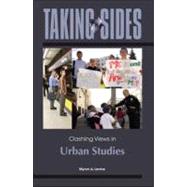
Table of Contents TAKING SIDES: Clashing Views in Urban Studies Unit 1 Urban Growth and Change: Recent Trends
Unit 2 Issues in Urban Economic Development
Unit 3 Debating Changes in Urban Policy
Unit 4 Debating Policies For Suburban And Regional Growth And Sustainability
Unit 5 Debating the Future Direction of Urban Policy
|
The New copy of this book will include any supplemental materials advertised. Please check the title of the book to determine if it should include any access cards, study guides, lab manuals, CDs, etc.
The Used, Rental and eBook copies of this book are not guaranteed to include any supplemental materials. Typically, only the book itself is included. This is true even if the title states it includes any access cards, study guides, lab manuals, CDs, etc.